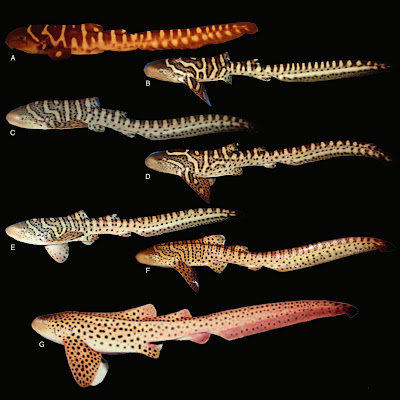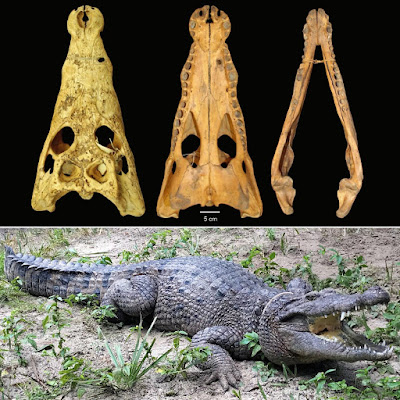[Most Recent Entries] [Calendar View]
Thursday, September 26th, 2019
| Time | Event | ||||||
| 3:35a | [Ichthyology • 2019] The Sandy Zebra Shark: A New Color Morph of the Zebra Shark Stegostoma tigrinum, with A Redescription of the Species and A Revision of Its Nomenclature
Abstract The Zebra Shark, in recent years known as Stegostoma fasciatum (Hermann, 1783), is well known for its dramatic ontogenetic change of color pattern, from striped (“zebra”) juveniles to spotted (“leopard”) adults. Nevertheless, many aspects of the species' biology, ecology, and morphology are still unknown or inadequately described, and its nomenclature is contentious. This study introduces a hitherto undescribed color morph of the Zebra Shark and provides an updated diagnosis and redescription of the species. Firstly, we establish that the Zebra Shark remains a single species based on genetic data from mitochondrial COI and ND4 markers. Secondly, through morphological analyses, we conclude that there are two morphs of the species, the known, zebra striped morph and a new, sandy colored morph. Both morphs were studied morphometrically to expose any ontogenetic changes, such as a decrease in the relative length of the tail with increasing total length (TL). The external coloration pattern clearly differentiates the two morphs, and both morphs can be further divided into three stages based on color pattern and size: juveniles (255–562 mm TL), transitionals (562–1395 mm TL), and adults (>1300 mm TL). The transitional sandy morph is dorsally covered by a swirly pattern of thin, dark brown bands edged with freckle-like brown spots. The adults are a uniform sandy beige, partially covered with brown freckles. A mature male of the zebra morph displayed a yet unknown feature of the claspers: a small, triangular spike extruding from the dorsal terminal of the clasper glands. Finally, we reviewed the nomenclature of the species and suggest that the original name Stegostoma tigrinum Forster, 1781 should be used as the senior synonym for the species. Stegostoma Müller and Henle, 1837 Squalus Seba, 1759; Forster, 1781; Hermann, 1783; Bloch, 1784; Broussonet, 1784; Bonnaterre, 1788; Gmelin, 1789; Pennant, 1791; Shaw, 1804; Bleeker, 1852; Gronow, 1854. Scyllia van Hasselt, 1823. Scyllium Rüppel, 1837. Stegostoma Müller and Henle, 1837; Blyth, 1847; Günther, 1870; Garman, 1913; Whitley, 1939; Bass et al., 1975; Dingerkus, 1986; Compagno, 2001; Goto, 2001; Weigmann, 2016. Stegostonea Regan, 1929: 293, possible error for Stegostoma Müller and Henle, 1837. Stegastoma Herre, 1934: 10, possible error for Stegostoma Müller and Henle, 1837. Stegastoma Last and Stevens, 1994: 138 apparent error for Stegostoma Müller and Henle, 1837. Type species.— Squalus fasciatus Bloch and Schneider, 1801, by original designation, equals Squalus fasciatus Hermann, 1783.
Stegostoma tigrinum Zebra Shark Diagnosis: Stegostoma tigrinum is characterized by a long caudal fin (49.9–54.2% TL) and five dorsolateral ridges along the body, visible even in hatchlings. Spiracles bean shaped, large (length 0.4–1.7% TL); eyes small (length 0.9–2.1% TL); barbels two, short (0.6–2.8% TL); gill slits five, but fourth and fifth partly fused so only four noticeable from a distance; pectoral fins large (anterior margin length 10.4–19.1% TL), broad and rounded; first dorsal fin originates far posteriorly above pelvic fins. Two color morphs, with a three-stage ontogenetic color and pattern change. Zebra morph: juveniles with dark brown background and cream colored bands (zebra-like); transitionals light brown with dark bands, broken up by dots; adults beige to yellow with spotted pattern (can be leopard-like). Sandy color morph: transitionals light beige background with swirly pattern of narrow, darker brown bands with tiny spots breaking up the pattern; adults uniformly sandy beige with tiny dark brown freckles. Maximum length 2050 mm TL, hatchlings approx. 250 mm TL; pectoral-fin rays of semi-plesodic structure, reaching approx. 66–88% of pectoral fin. Total vertebrae 207–262, monospondylous precaudal vertebrae 43–49, diplospondylous precaudal vertebrae 38–50, diplospondylous caudal vertebrae 120–175, precaudal vertebrae 81–101. Tooth rows upper jaw: 13–30, lower jaw: 22–30, and series count, upper jaw: 7–27, lower jaw: 8–16. Ring-type intestine with 18–20 valvular turns. ... Distribution: The sandy color morph of S. tigrinum has in the present study been documented from a single location, off the coast of Kenya, ca. 10 km north of Malindi (Fig. 9). Six specimens of this morph were caught in June 2016 (rainy season) at a depth of 12 m, on a sandy substrate. A seventh specimen was caught in May 2017, 15 km north of Malindi on sandy bottom, also at 12 m depth. Etymology: The name Stegostoma tigrinum is made up of the Greek stego meaning cover, and stoma meaning mouth, and can thus be translated to ‘covered mouth' (Froese and Pauly, 2018). The epithet tigrinum refers to the juveniles’ banded pattern. Rikke Beckmann Dahl, Eva Egelyng Sigsgaard, Gorret Mwangi, Philip Francis Thomsen, René Dalsgaard Jørgensen, Felipe de Oliveira Torquato, Lars Olsen and Peter Rask Møller. 2019. The Sandy Zebra Shark: A New Color Morph of the Zebra Shark Stegostoma tigrinum, with A Redescription of the Species and A Revision of Its Nomenclature. Copeia. 107(3); 524-541. DOI: 10.1643/CG-18-115 | ||||||
| 4:13a | [Herpetology • 2019] Crocodylus halli • Divergent Morphology among Populations of the New Guinea Crocodile, Crocodylus novaeguineae (Schmidt, 1928): Diagnosis of An Independent Lineage and Description of A New Species
Abstract The freshwater crocodile inhabiting Papua New Guinea, currently recognized as Crocodylus novaeguineae, exhibits morphological, molecular, and ecological divergence between the northern and southern versants of the Central Highlands and occupies separate evolutionary trajectories. A robust body of work has long encouraged the formal description of New Guinea crocodiles from the southern versant of the highlands as a distinct lineage with a taxonomy that reflects diagnosed relationships. Here, we use geometric morphometric techniques to assess cranial shape variation between specimens from both versants and add to the diagnostic evidence supporting a more accurate taxonomy. Further, herein, we formally describe the southern variant as a distinct lineage (Hall's New Guinea Crocodile; Crocodylus halli, new species).
Crocodylus halli, new species urn:lsid:zoobank.org:act:2B819FD7-B74C-4 Hall's New Guinea Crocodile Diagnosis.— Crocodylus halli is readily separated from C. novaeguineae based on a longer frontal bone (versus shorter in C. novaeguineae); a shorter maxilla and nasal (versus longer in C. novaeguineae); long and wide postorbital and squamosal (versus short and narrow in C. novaeguineae); and a wider palatine of pterygoid that extends posteriorly (versus narrow and medially oriented in C. novaeguineae). Additionally, C. halli possesses no more than four non-contiguous post-occipital scutes, versus four to six contiguous post-occipital scutes in C. novaeguineae. Species description and variation.— Variation in morphology of adult Crocodylus halli exists among drainages, with specimens from Lake Murray exhibiting a skull width that is more than half of the skull length (posteromedial squamosal to anteromedial premaxilla), resulting in the appearance of a stocky and wide head in adults. Specimens from Aramia River have generally longer maxilla and shorter postcranial elements than Lake Murray individuals, while maintaining shorter maxilla and longer postcranial elements than C. novaeguineae. Juveniles retain morphology consistent with ontogenetic constraints, exhibiting a relatively enlarged orbit and compressed postcranial elements. Distribution.— Crocodylus halli occurs within drainages south of the Central Highlands of Papua New Guinea in swamps, rivers, lakes, and occasionally estuaries. Natural history.— Females of C. halli nest in the rainy season (November–April) and lay larger eggs in smaller clutches than C. novaeguineae, which nests near end of the dry season (July–November; Cox, 1985; Hall, 1985; Hall and Johnson, 1987). Etymology.— The specific epithet recognizes the fieldwork and research of Philip Hall whose contributions provided the initial framework for supporting distinctiveness of this species. Christopher M. Murray, Peter Russo, Alexander Zorrilla and Caleb D. McMahan. 2019. Divergent Morphology among Populations of the New Guinea Crocodile, Crocodylus novaeguineae (Schmidt, 1928): Diagnosis of An Independent Lineage and Description of A New Species. Copeia. 107(3); 517-523. DOI: 10.1643/CG-19-240 | ||||||
| 6:44a | [Herpetology • 2019] Boiga thackerayi • A New Species of Boiga Fitzinger, 1826 (Serpentes: Colubridae) from The Northern Western Ghats of India
Abstract A new species of colubrid snake of the genus Boiga Fitzinger, 1826 is described, based on three specimens. Boiga thackerayi sp. nov. is presently known only from its type locality from a hill stream near Koyna, Satara district in northern Western Ghats of peninsular India. A medium sized Boiga characterized by smooth dorsal scales arranged in 19/19-17/15 rows, ventrals 211-221; subcaudals 93-101, dorsum with indistinct bands and belly distinctly marked. This is the second species of Boiga after B. dightoni that is endemic to the Western Ghats and the first new species of Boiga described after 125 years from the Western Ghats. The molecular data also proved the distinctiveness of this species from its congeners from India and Sri Lanka, which was supported by a limited but precise set of morphological variations. This is apparently the first known species of Boiga which feeds on frog eggs. Keywords: Boiga ceylonensis, Cat Snake, DNA, Taxonomy, Types, Wet Zones. Boiga thackerayi sp. nov. Varad B. Giri, V. Deepak, Ashok Captain, Swapnil Pawar and Frank Tillack. 2019. A New Species of Boiga Fitzinger, 1826 (Serpentes: Colubridae) from The Northern Western Ghats of India. Journal of Bombay Natural History Society. 116. DOI: 10.17087/jbnhs/2019/v116/144901 |
| << Previous Day |
2019/09/26 [Calendar] |
Next Day >> |















